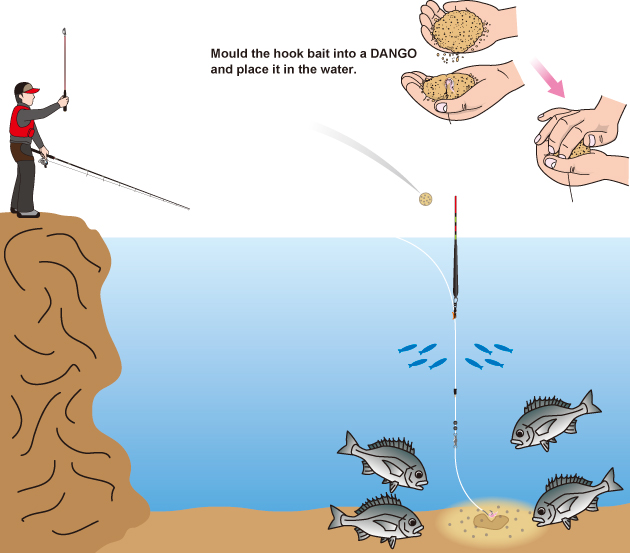UKI DANGO FISHING
UKI DANGO fishing involves molding hook baits such as krill tightly into a DANGO and casting it into the fishing point. Once the DANGO reaches the sea bottom and starts to break up, the hook bait appears and your target fish will eat it. You can then tell whether there is a bite from the float on the water surface.

The DANGO sinks to the sea bottom while emitting a cloud. Smaller fish close to the water surface react to this cloud, allowing the hook bait to reach the bigger fish at the sea bottom. The hook bait releases from the DANGO and your target fish can then eat it.
When the DANGO breaks up and the hook bait is released, there is a high probability of bites. If you don't get any bites after waiting for a while, try attaching some more hook bait and molding it into a DANGO.
Try Using a Different Float
The first thing to do is balance your float. Add split-shot sinkers to the line to get the float to sit at an easy to see depth. The next thing to do check the depth of the water. Knowing what is below the water is very important when fishing.

You can either cast the DANGO with your hands or with a bait caster. If the point is further out and requires a log cast, the bait caster can be a convenient choice to use.

KAKARI FISHING
KAKARI fishing takes place on a raft or boat in the bay, targeting fish with a short rod of around 1.5m and DANGO baits. This is a thrilling form of fishing that uses a specialized rod with a fine tip and involves searching for smaller bites.

1. Once you've arrived at your fishing area, you should first cast in a few DANGOs to setup your point of fishing. The fish in the vicinity will then start to gather near the fishing point. When casting in the DANGO, drop it quietly in front of you so they don't break up easily. |
|

2. Prepare your fishing gear, and mould the hook bait into a DANGO before casting. |
| |
|
|

3. After the DANGO reaches the sea bottom, wait with a little slack in the line. Once the hook bait releases from the broken down DANGO, lightly lift the tip of the rod. There tends to be a lot of bites at the moment the DANGO breaks down, so focus on the tip of the rod and be ready for the fish. |
|

4. If there are no bites after the DANGO has broken down, gradually release the line so that the hook bait crawls close to the sea bottom. When the fish eat the hook bait, you will notice the bite from the tip of the rod. |
|
|












